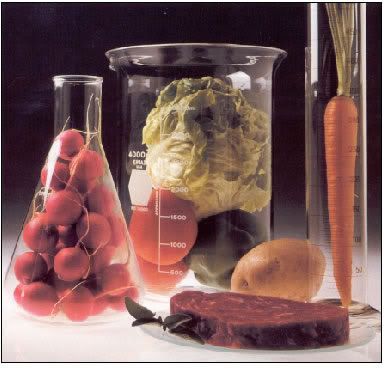Dietary carbohydrate modification enhances insulin secretion in persons with the metabolic syndrome.
INTRODUCTION
We previously showed that, compared with white-wheat bread ingestion, ingestion of whole-kernel rye bread reduces postprandial insulin, glucose-dependent insulinotropic polypeptide, and glucagon-like peptide 1 responses in healthy persons. This was not due to fiber content, because low-fiber rye bread reduced the insulin and incretin responses similar to high-fiber rye bread. In a randomized crossover trial conducted in 20 postmenopausal women, we also found that the acute insulin response measured during a frequently sampled intravenous-glucose-tolerance test increased after 8 wk of a diet high in high-fiber rye bread compared with a diet high in white or wheat bread, but insulin sensitivity remained unchanged.
Men and women with the metabolic syndrome are particularly at a high risk of developing type 2 diabetes and cardiovascular disease. Insulin resistance is a core component of the metabolic syndrome. Compensatory hypersecretion of insulin is the normal response, but ß cell dysfunction is also frequently present, especially in persons who are susceptible to impaired glucose tolerance and diabetes. ß cell dysfunction, commonly characterized by the loss of first-phase insulin secretion, is a prerequisite for the development of impaired glucose tolerance (IGT) and type 2 diabetes and seems to be a primary determinant of persons with insulin resistance who will eventually develop IGT or diabetes. Therefore, interventions that alleviate insulin resistance or enhance insulin secretion without long-term deleterious effects on ß cell function are especially important for the prevention of worsening glucose tolerance in these high-risk persons.
Dietary carbohydrate modification would be expected to have especially pronounced effects on insulin and glucose homeostasis in persons with the metabolic syndrome, but such data, especially in the absence of weight loss, are largely lacking. Therefore, we assessed the effect of carbohydrate modification on insulin and glucose metabolism in 72 overweight or obese men and women with the metabolic syndrome, which was defined according to the National Cholesterol Education Program criteria. Carbohydrate modification consisted of a diet based on rye bread and pasta compared with a diet high in wheat and oat bread and potatoes. We hypothesized that repeatedly lower postprandial insulin and glucose excursions with the rye bread and pasta diet would improve insulin sensitivity and secretion and glucose tolerance, even in the absence of weight loss.
DISCUSSION
ß cell dysfunction is a prerequisite for the development of IGT and type 2 diabetes and seems to be a primary determinant of those persons with insulin resistance who will eventually develop IGT or diabetes. Indeed, persons who progress from normal glucose tolerance to IGT and type 2 diabetes are characterized by a lower first-phase insulin response and an additional decline with time in the acute insulin response, even though the second-phase response is initially exaggerated. In contrast, nonprogressors generally show little decline in ß cell function.
Improvement in the acute insulin response in the absence of deleterious changes on insulin sensitivity may therefore lower the risk of worsening glucose tolerance and development of frank diabetes. The importance of acute insulin secretion on glucose tolerance was also evident in the present study. A higher IGI and an increase in the IGI during the study were associated with improved glucose tolerance in both groups as measured by the glucose AUC.
Rye bread and pasta intake may improve acute insulin secretion by chronically lowering postprandial insulin responses and allowing ß cell function to recover. We have shown that both rye bread and pasta consumption reduce the postprandial insulin and incretin responses compared with wheat and oat bread consumption. For rye bread, this occurred in the absence of changes in the postprandial glycemic response, although others have found that rye bread also has a lower glycemic index than does wheat bread. The lower postprandial insulin excursions that were observed after rye bread consumption may be due to bread structure. Fiber content does not account for the lower postprandial insulin response to rye bread, because the postprandial insulin response to low-fiber rye bread was as low as that of high-fiber rye bread. Rye bread contains phenylalanine derivatives that are similar to nateglinide, a phenylalanine derivative that is an oral hypoglycemic agent and acts by improving early insulin secretion.
Our finding that rye and pasta intake improved early insulin secretion in men and women with the metabolic syndrome is consistent with our previous observation that 8 wk of high-fiber rye bread consumption enhanced the acute insulin response mainly in normoglycemic postmenopausal women. Lifestyle measures that are aimed at preventing type 2 diabetes usually mediate their effects by decreasing insulin resistance, with only indirect effects on insulin secretion. Weight loss and, at least in type 2 diabetic patients, physical activity may nonetheless improve insulin secretion. A high-carbohydrate, low–glycemic index diet has also improved insulin secretion (as measured by the DI) compared with a high-carbohydrate, high–glycemic index diet in persons with IGT. Our study focused on high intake of bread with modification of the grain sources and a relatively minor differential intake of pasta and potatoes rather than focusing on the glycemic index. The low–glycemic index diet in the study by Wolever and Mehling also emphasized pasta and rye bread, however, and the high–glycemic index diet emphasized potato and wheat bread. Altogether, the present and previous studies provide evidence that carbohydrate modification can improve early insulin secretion, even in the absence of weight loss.
We sought to maintain weight at prestudy levels to remove the confounding effects of weight change on the results. No significant changes in the mean body weight occurred in either group. Even so, modest weight gain obviated the relative benefit of rye and pasta intake. Overweight and obesity, insulin resistance, insulin secretion, and glucose tolerance are all physiologically intertwined. Obesity is a powerful determinant of insulin resistance. Insulin secretion and insulin resistance have a hyperbolic relation, and weight gain and increased insulin resistance result in a compensatory increase in both first- and second-phase insulin secretion, at least if ß cell secretory capacity is sufficient. Moreover, changes in insulin secretion and even modest changes in weight have an effect on glucose tolerance over a relatively short follow-up period, as shown in the present study. Our findings also underscore the importance of successful weight maintenance to maximize the benefits of carbohydrate modification on insulin and glucose homeostasis.
Even though rye and pasta intake improved early insulin secretion, the improvement in glucose tolerance as measured by the glucose AUC was not significant. The modifying effect of even modest weight gain may partly explain why no significant effect was seen on glucose tolerance. Other reasons for the lack of a significant effect may be the relatively short duration of the present study and a lack of statistical power.
The IGI is a commonly used measure of early insulin secretory capacity. This index has moderately high correlations with acute insulin responses that are measured during a frequently sampled intravenous glucose tolerance test (r = 0.47–0.61) and an intravenous arginine stimulation (r = 0.41–0.50). The IGI and the DI have also consistently predicted progression from normal glucose tolerance to IGT and to type 2 diabetes. Although the IGI is often considered to be less precise than intravenous methods, the IGI calculated from an OGTT may be more physiologic because the gastrointestinal contribution to insulin secretion is not bypassed. Incretins play a key role in mediating insulin secretion and account for approximately two-thirds of the insulin secreted in response to a glucose load during the OGTT. Moreover, incretins may also be important in the pathogenesis of deteriorating glucose tolerance and of type 2 diabetes.
Because early insulin secretion and insulin sensitivity have a hyperbolic relation, insulin sensitivity should be accounted for when assessing the acute insulin response in interventions that may alter insulin secretion or sensitivity. We did this by adjusting for insulin sensitivity, which was estimated by QUICKI, and by calculating the DI (the product of the IGI and QUICKI). In principle, adjusting for insulin sensitivity rather than multiplying by insulin sensitivity should reduce the variability of the index. However, the DI was as repeatable as the QUICKI-adjusted IGI, and the effect of rye and pasta intake in improving the early insulin response was similar regardless of which measure was used.
Modification of carbohydrate intake by replacement of cereal products with rye-based products and increased pasta intake over a 12-wk period improved early insulin secretion measured during an OGTT compared with an oat-wheat-potato-based diet in men and women with the metabolic syndrome. Glucose tolerance did not improve, possibly in part because even modest weight gains abolished the relative benefit of the rye-pasta diet on insulin secretion. Emphasis of rye and pasta intake coupled with effective weight maintenance may have long-term benefits on ß cell function and glucose tolerance in persons who are at high risk for developing type 2 diabetes and cardiovascular disease.
Conclusions:
In several epidemiologic studies, whole-grain cereals and diets with a low glycemic index have been shown to protect against the development of type 2 diabetes and heart disease. The major mechanism by which whole-grain cereals and low–glycemic index diets mediate their effects is thought to be through decreased insulin resistance and improved ß cell function.
We previously showed that, compared with white-wheat bread ingestion, ingestion of whole-kernel rye bread reduces postprandial insulin, glucose-dependent insulinotropic polypeptide, and glucagon-like peptide 1 responses in healthy persons. This was not due to fiber content, because low-fiber rye bread reduced the insulin and incretin responses similar to high-fiber rye bread. In a randomized crossover trial conducted in 20 postmenopausal women, we also found that the acute insulin response measured during a frequently sampled intravenous-glucose-tolerance test increased after 8 wk of a diet high in high-fiber rye bread compared with a diet high in white or wheat bread, but insulin sensitivity remained unchanged.
Men and women with the metabolic syndrome are particularly at a high risk of developing type 2 diabetes and cardiovascular disease. Insulin resistance is a core component of the metabolic syndrome. Compensatory hypersecretion of insulin is the normal response, but ß cell dysfunction is also frequently present, especially in persons who are susceptible to impaired glucose tolerance and diabetes. ß cell dysfunction, commonly characterized by the loss of first-phase insulin secretion, is a prerequisite for the development of impaired glucose tolerance (IGT) and type 2 diabetes and seems to be a primary determinant of persons with insulin resistance who will eventually develop IGT or diabetes. Therefore, interventions that alleviate insulin resistance or enhance insulin secretion without long-term deleterious effects on ß cell function are especially important for the prevention of worsening glucose tolerance in these high-risk persons.
Dietary carbohydrate modification would be expected to have especially pronounced effects on insulin and glucose homeostasis in persons with the metabolic syndrome, but such data, especially in the absence of weight loss, are largely lacking. Therefore, we assessed the effect of carbohydrate modification on insulin and glucose metabolism in 72 overweight or obese men and women with the metabolic syndrome, which was defined according to the National Cholesterol Education Program criteria. Carbohydrate modification consisted of a diet based on rye bread and pasta compared with a diet high in wheat and oat bread and potatoes. We hypothesized that repeatedly lower postprandial insulin and glucose excursions with the rye bread and pasta diet would improve insulin sensitivity and secretion and glucose tolerance, even in the absence of weight loss.
DISCUSSION
In the present randomized parallel study, we modified the intake of carbohydrates by replacing nearly all cereals that were consumed by men and women with the metabolic syndrome with either oat-wheat breads or rye breads. We also modified carbohydrate intake by emphasizing potato intake in the oat-wheat-potato group and pasta intake in the rye-pasta group. The main finding was that rye bread and pasta intake increased first-phase insulin secretion, as measured by the IGI during the intervention, more than did oat-wheat breads and potato intake in these high-risk persons with the metabolic syndrome. No significant changes were seen in glucose responses during the study.
ß cell dysfunction is a prerequisite for the development of IGT and type 2 diabetes and seems to be a primary determinant of those persons with insulin resistance who will eventually develop IGT or diabetes. Indeed, persons who progress from normal glucose tolerance to IGT and type 2 diabetes are characterized by a lower first-phase insulin response and an additional decline with time in the acute insulin response, even though the second-phase response is initially exaggerated. In contrast, nonprogressors generally show little decline in ß cell function.
Improvement in the acute insulin response in the absence of deleterious changes on insulin sensitivity may therefore lower the risk of worsening glucose tolerance and development of frank diabetes. The importance of acute insulin secretion on glucose tolerance was also evident in the present study. A higher IGI and an increase in the IGI during the study were associated with improved glucose tolerance in both groups as measured by the glucose AUC.
Rye bread and pasta intake may improve acute insulin secretion by chronically lowering postprandial insulin responses and allowing ß cell function to recover. We have shown that both rye bread and pasta consumption reduce the postprandial insulin and incretin responses compared with wheat and oat bread consumption. For rye bread, this occurred in the absence of changes in the postprandial glycemic response, although others have found that rye bread also has a lower glycemic index than does wheat bread. The lower postprandial insulin excursions that were observed after rye bread consumption may be due to bread structure. Fiber content does not account for the lower postprandial insulin response to rye bread, because the postprandial insulin response to low-fiber rye bread was as low as that of high-fiber rye bread. Rye bread contains phenylalanine derivatives that are similar to nateglinide, a phenylalanine derivative that is an oral hypoglycemic agent and acts by improving early insulin secretion.
Pasta consumption results in considerably lower postprandial glucose and insulin responses than does mashed or boiled potato consumption. Pasta and potato intake are unlikely to explain the differences between the 2 groups, however, because energy intake from bread was several-fold greater than that from pasta and potatoes. Intake of soluble dietary fiber, the composition of dietary fat intake, and the relative proportions of dietary saturated fat, carbohydrate, and protein intakes could possibly influence insulin secretion, but adjustment for changes in the dietary intake of soluble and insoluble fiber, carbohydrate, protein, and saturated fat did not significantly affect the results.
Our finding that rye and pasta intake improved early insulin secretion in men and women with the metabolic syndrome is consistent with our previous observation that 8 wk of high-fiber rye bread consumption enhanced the acute insulin response mainly in normoglycemic postmenopausal women. Lifestyle measures that are aimed at preventing type 2 diabetes usually mediate their effects by decreasing insulin resistance, with only indirect effects on insulin secretion. Weight loss and, at least in type 2 diabetic patients, physical activity may nonetheless improve insulin secretion. A high-carbohydrate, low–glycemic index diet has also improved insulin secretion (as measured by the DI) compared with a high-carbohydrate, high–glycemic index diet in persons with IGT. Our study focused on high intake of bread with modification of the grain sources and a relatively minor differential intake of pasta and potatoes rather than focusing on the glycemic index. The low–glycemic index diet in the study by Wolever and Mehling also emphasized pasta and rye bread, however, and the high–glycemic index diet emphasized potato and wheat bread. Altogether, the present and previous studies provide evidence that carbohydrate modification can improve early insulin secretion, even in the absence of weight loss.
We sought to maintain weight at prestudy levels to remove the confounding effects of weight change on the results. No significant changes in the mean body weight occurred in either group. Even so, modest weight gain obviated the relative benefit of rye and pasta intake. Overweight and obesity, insulin resistance, insulin secretion, and glucose tolerance are all physiologically intertwined. Obesity is a powerful determinant of insulin resistance. Insulin secretion and insulin resistance have a hyperbolic relation, and weight gain and increased insulin resistance result in a compensatory increase in both first- and second-phase insulin secretion, at least if ß cell secretory capacity is sufficient. Moreover, changes in insulin secretion and even modest changes in weight have an effect on glucose tolerance over a relatively short follow-up period, as shown in the present study. Our findings also underscore the importance of successful weight maintenance to maximize the benefits of carbohydrate modification on insulin and glucose homeostasis.
Even though rye and pasta intake improved early insulin secretion, the improvement in glucose tolerance as measured by the glucose AUC was not significant. The modifying effect of even modest weight gain may partly explain why no significant effect was seen on glucose tolerance. Other reasons for the lack of a significant effect may be the relatively short duration of the present study and a lack of statistical power.
The IGI is a commonly used measure of early insulin secretory capacity. This index has moderately high correlations with acute insulin responses that are measured during a frequently sampled intravenous glucose tolerance test (r = 0.47–0.61) and an intravenous arginine stimulation (r = 0.41–0.50). The IGI and the DI have also consistently predicted progression from normal glucose tolerance to IGT and to type 2 diabetes. Although the IGI is often considered to be less precise than intravenous methods, the IGI calculated from an OGTT may be more physiologic because the gastrointestinal contribution to insulin secretion is not bypassed. Incretins play a key role in mediating insulin secretion and account for approximately two-thirds of the insulin secreted in response to a glucose load during the OGTT. Moreover, incretins may also be important in the pathogenesis of deteriorating glucose tolerance and of type 2 diabetes.
Because early insulin secretion and insulin sensitivity have a hyperbolic relation, insulin sensitivity should be accounted for when assessing the acute insulin response in interventions that may alter insulin secretion or sensitivity. We did this by adjusting for insulin sensitivity, which was estimated by QUICKI, and by calculating the DI (the product of the IGI and QUICKI). In principle, adjusting for insulin sensitivity rather than multiplying by insulin sensitivity should reduce the variability of the index. However, the DI was as repeatable as the QUICKI-adjusted IGI, and the effect of rye and pasta intake in improving the early insulin response was similar regardless of which measure was used.
Modification of carbohydrate intake by replacement of cereal products with rye-based products and increased pasta intake over a 12-wk period improved early insulin secretion measured during an OGTT compared with an oat-wheat-potato-based diet in men and women with the metabolic syndrome. Glucose tolerance did not improve, possibly in part because even modest weight gains abolished the relative benefit of the rye-pasta diet on insulin secretion. Emphasis of rye and pasta intake coupled with effective weight maintenance may have long-term benefits on ß cell function and glucose tolerance in persons who are at high risk for developing type 2 diabetes and cardiovascular disease.
Conclusions:
Rye bread and pasta-based carbohydrate modification enhances early insulin secretion in persons with the metabolic syndrome, which may lower the risk of deteriorating glucose tolerance and development of type 2 diabetes.




0 Comments:
Post a Comment
<< Home